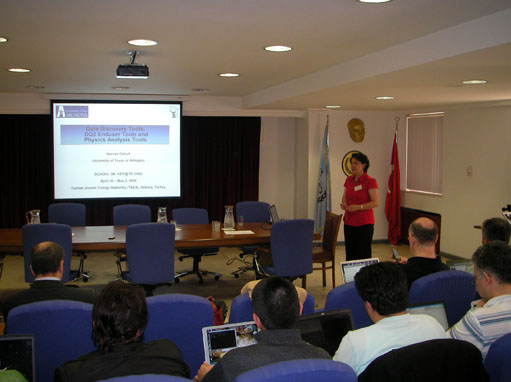
ATLAS e-News
23 February 2011
ATLAS Meeting in Ankara, Turkey
9 June 2008

A picture taken during an ATLAS talk at the HEP@TR-GRID School in the conference room of the Turkish Atomic Energy Authority (TAEK) building in Ankara.
With the upcoming ATLAS data taking this year, distributing the computing resources worldwide becomes important to enable any ATLAS physicists based at a remote location to extract physics results. ATLAS is adding more sites in its Grid computing system and is testing the distribution and analysis of data at remote sites. In preparation for this remote participation, an ATLAS meeting took place in Ankara, Turkey as part of a three day Grid school from April 30th to May 2nd, 2008.
Organised by Ilkay Turk Cakir and her colleagues from the Turkish Atomic Energy Authority (TAEK) and the Turkish Academic Network and Information Center (ULAKBIM), the school aimed at training participants from national institutes with the usage of Turkish Grid resources and services to get prepared for the upcoming data analysis for the ATLAS and CMS experiments later this year.
Turkey has been a CERN observer country since 1986 participating in many experiments at CERN. A notable one was the CHORUS experiment in the past. Turkish physicists have now been active members of the ATLAS, CMS, ALICE, CAST and CLIC-CTF3 collaborations. To increase the level of contribution to the CERN experiments, a memorandum of understanding was signed between TAEK and CERN in January 2008 to participate in the WLCG (World Wide LHC Computing Grid) collaboration.
Furthermore a formal cooperation agreement has recently been signed between TAEK and CERN in April 2008. With this agreement Turkey's participation in the experimental physics program of CERN has been formalised. Two universities, Ankara University and Bogazici University, represent Turkey in ATLAS in close collaboration with five other universities; Gazi, Gaziantep, Dogus, Dumlupinar and TOBB.
The Turkish-Grid (TR-Grid) infrastructure has been established as part of the Enabling Grids for E-sciencE (EGEE) project starting in 2004 under the leadership of ULAKBIM which is an R&D facility institute of the Scientific and Technological Research Council of Turkey (TUBITAK). Eight EGEE certified grid sites with about a thousand CPU’s have been brought online. Two of the sites, TR-10-ULAKBIM and TR-03-METU, are now dedicated to ATLAS and CMS, respectively, to deploy a Tier-2 center. In total, 450 CPU’s and 160 TB of disk space are planned to be pledged to ATLAS in 2008.
The school was exciting for young researchers who expect to participate in the data analysis for the ATLAS and CMS experiments from a remote location. The three-day school introduced the TR-Grid resources, tools and services to the participants in the first day, following the CMS and ATLAS sessions in the second and third day, respectively.
Roger Jones, Kaushik De and myself were invited speakers from ATLAS. We talked about the ATLAS computing model, ATLAS software, Production ANd Distributed Analysis (PanDA) system, Distributed Data Management (DDM) system, data discovery tools, DDM end-user tools, Physics Analysis Tools and Analysis Model.
A demo was given on the monitoring of production and analysis jobs in the PanDA system as well as a tutorial for the distributed data analysis on the Grid using pAthena and GANGA. The first steps toward testing data transfers between ATLAS Tier-1 sites and TR-Grid Tier2 site were also taken while the selection process for which Tier-1 site to be attached to still continues.

Nurcan OzturkUniversity of Texas at Arlington
|